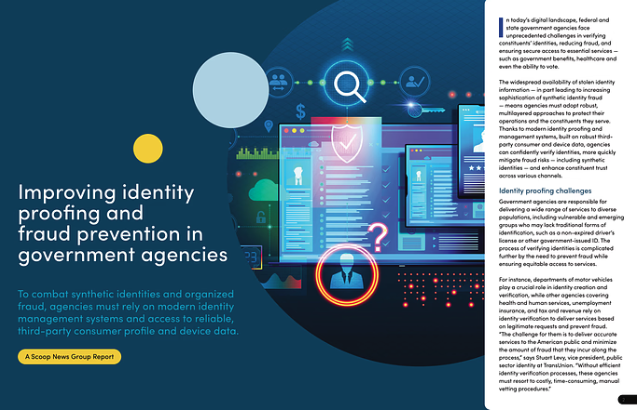- Sponsored
- Insights
Ramping up digital fraud prevention with advanced verification tools

In an era of increasing digital fraud, federal and state government agencies are ramping up efforts to strengthen identity verification and fraud prevention systems. Modern solutions integrating third-party consumer data and device intelligence are becoming essential to combat synthetic identities and safeguard public services, according to a new report produced by Scoop News Group for TransUnion.
Government services, from unemployment benefits to healthcare, depend on effective identity proofing. However, traditional methods are often insufficient, especially for vulnerable populations lacking standard IDs. According to the report, fraudsters exploit these gaps, creating synthetic identities — combinations of real and fake personal information — to bypass checks. The U.S. Government Accountability Office estimates that federal agencies lose up to $521 billion annually due to fraud.

The report also emphasizes that digital fraud threats are intensifying. Between January and December 2023, suspicious digital transactions reported by TransUnion’s public sector clients rose from 4.2% to 5.8%. Additionally, data breaches have increased by 61% since 2020, providing fraudsters access to compromised Social Security numbers, passports and other sensitive information. This stolen data fuels fraud schemes across multiple channels, including call centers, where social engineering attacks often target inexperienced staff.
TransUnion’s Vice President of Public Sector Identity, Stuart Levy, stresses the importance of efficient identity verification. “Without effective processes, agencies face high costs from manual checks and risk undermining public trust,” he says.
TransUnion’s advanced tools, such as the TruValidate suite, are helping agencies enhance security and constituent experiences by verifying identities in real-time and reducing fraud exposure. These solutions analyze both individual identity and device-based behaviors, offering multilayered protection. For example, device risk tools monitor suspicious patterns to detect fraud rings, while phone takeover solutions mitigate the risk of unauthorized access following SIM swaps.
Several agencies have already achieved significant benefits using these tools. For instance, a federal government benefits program automated its re-verification process, saving over $40 million and 1.3 million person-hours.
The report recommends that agencies adopt robust identity verification tools, integrate them with existing systems and regularly audit processes to address emerging fraud trends. Jay Johns, TransUnion business development advisor for public sector fraud and identity, stressed the importance of quantifying fraud risks, noting that “many agencies still lack the mechanisms to fully understand the scale of fraud they face.”
As agencies continue to digitize services, deploying innovative fraud prevention systems will be crucial to maintaining security and ensuring equitable access for legitimate users.
Read more about how agencies can integrate modern solutions to improve their ability to confidently verify identities and provide legitimate constituents with more secure access to services.
This article was produced by Scoop News Group, for FedScoop and StateScoop, and sponsored by TransUnion.





